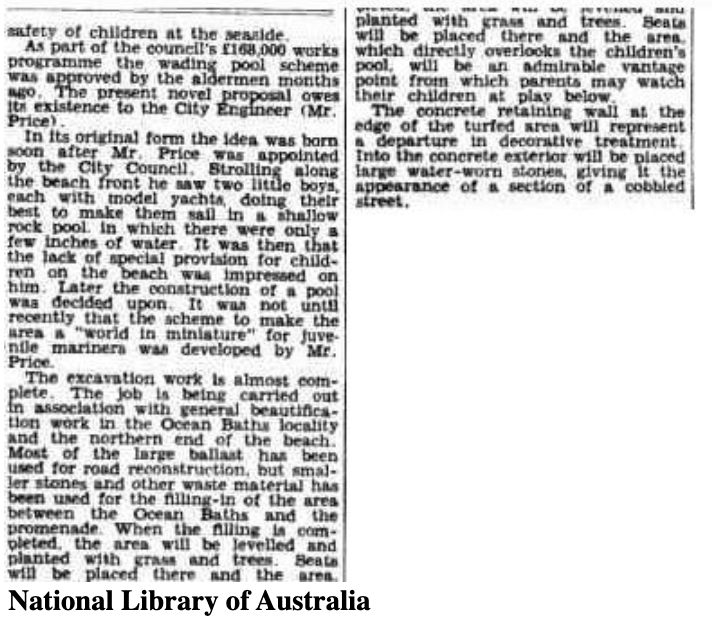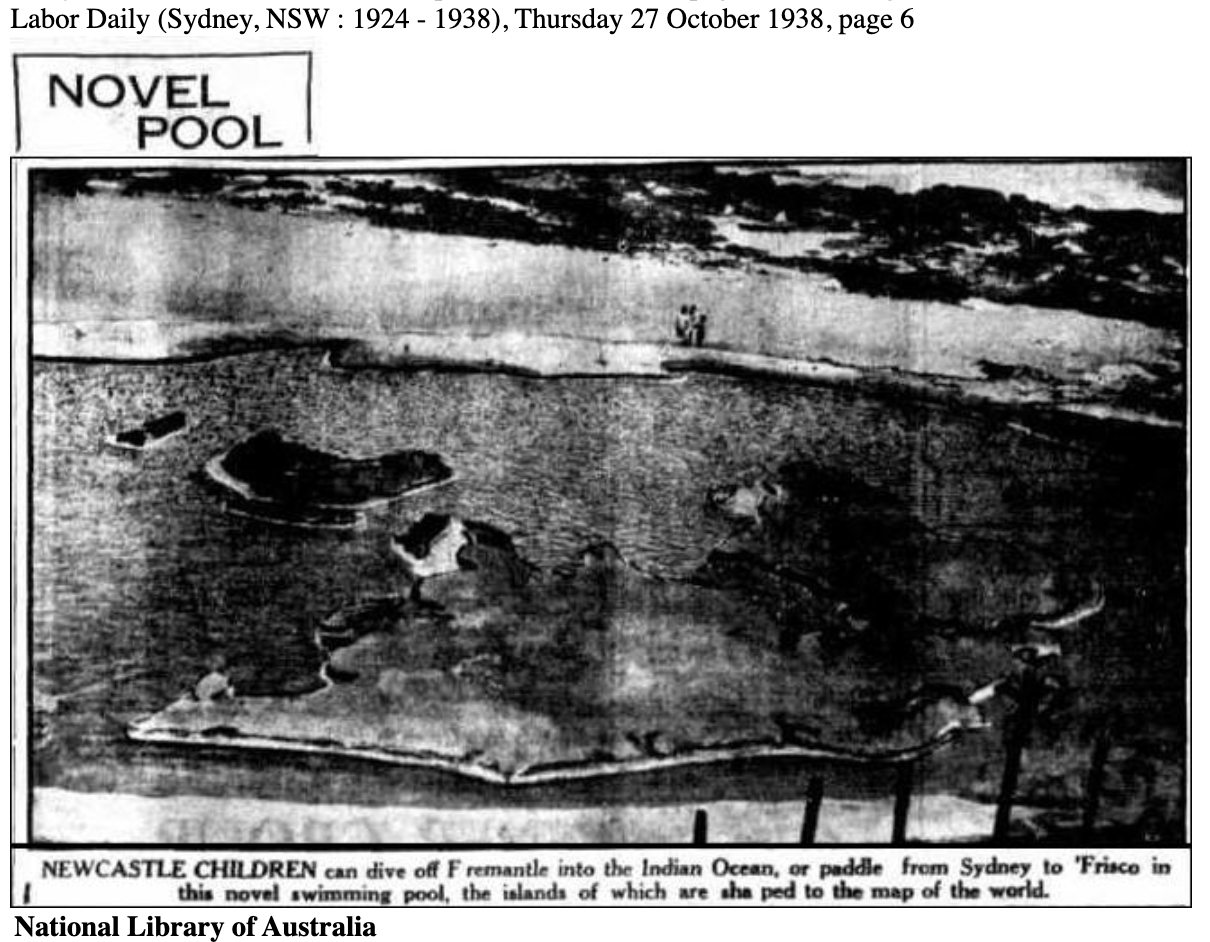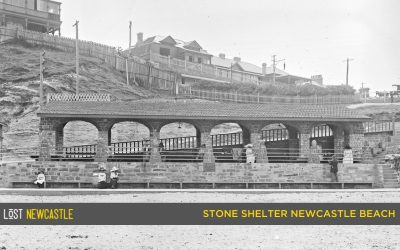
The existence, or not, of the map in the pool has become the stuff of legend.
Many people don’t think it was ever there. Others argue that they had PERSONALLY ‘ jumped off Africa’!
It did exist, but debate still rages today about the fate of the map. Is it still there under the sand? Was it removed? What happened to Newcastle’s Young Mariners Pool?
The question of the ‘map pool’, the Young Mariners Pool, canoe pool – whatever – seems to come up regularly.
Many are convinced the map is still there but it was removed by Newcastle City Council decades ago.
Or was it?
In 1934, it was proposed that a one-metre high wall be built on the southern end of the Ocean Baths to protect it from rough seas and from being filled with sand. This area would then be available as a paddling pool for children.
In 1936, a gang of men hollowed out a shallow oval in the rocks, 45 cm deep. The waste material was used to fill a low triangular section of the rocks area between the new pool, the southern wall of the Ocean Baths and the beach promenade. The larger rocks were used to add strength to other concrete walls constructed along the beach. Other types of rocks were used in the rockeries along Watt Street. Later the bottom of the paddling pool would be covered with sand to guard against bruised or cut feet.
In 1937, the Mariners’ Pool was constructed. This pool would later be referred to as the Geographical or Map Pool. This circular pool was 20 metres across, boasting a pigmented cement map of the world on the bottom. Countries, red-dyed for the Commonwealth and the rest green, were about 60cm thick, with 20cm jutting above the water line.
The Young Mariners’ Pool was hugely popular and very quickly became overcrowded. The City Engineer, Mr L.J. Price, conceived building the larger pool to relieve the pressure and in 1939, a Canoe Pool, for the sailing of canoes, was built beside the Map Pool.
It was constructed in concrete with depth controlled by sluice gates 2.4 metres wide and 1.2 metres deep.
Therefore, the maximum depth could never be more than 1.2 metres, with the pool’s sanding following closure providing an effective depth of 1 metre.
The pool was to be filled with waves at every high tide, and the geographical pool would fill from it with a continuous flow the whole of its use. The canoe pool was filled by the action of the tide on 8 November 1939, after the sluice gates were closed for the first time.
In late 1939, pumping equipment was installed and a suction line was laid to permit fresh salt water to be pumped into the pools when required. On days when the pools were in demand, the pumps could be worked continuously.
Peter Walmsley, licencee of the Newcastle Ocean Baths in 1988 and an old school mate of Ben Lexcen, remembered sailing boats from Australia to the US and back again with the great Australian engineer when he was about six in the 1940s. He believed the pool began falling into disrepair in the late 1960s.
In 1981, Newcastle City Council Deputy Town Clerk Mr. Keith Swan said years ago the council cleared the sand from the map whenever it became covered.
But then state legislation was enacted preventing the removal of sand from beaches. The problem was not removing the sand but keeping it out, it kept coming back with every high sea. In the early 1970s, nature won its longstanding fight to cover the world with sand.
Because the water in the Map Pool would get trapped it was always a bit murky. When health regulations became more stringent the council had to keep the water clean. Pumps were set up to bring fresh water into the pool from the baths. The cost of pumping the water and keeping the sand out of the pool eventually became prohibitive and it was left to the elements.
Newcastle’s former Lord Mayor, Alderman McNaughton, who also swam in the pool as a child, was fairly confident (when asked in 1988) that most of the concrete slabs of countries were removed from the pool years before.
A study in the early 1980s into the feasibility of restoring the pool found that the cost of maintaining it would be prohibitive.
During large swells, it’s still possible to see the colourful remnants of the Young Mariners’ Pool on the eastern edge of the pool.














In the summer of 1954-55 I was 4 yrs old and swimming in the pool in a rubberized ring with a blue swimming cap on. There were quite a few children and adults in the pool including a sibling, and a few adults standing on the surrounding concrete ring. Unfortunately the sluice gate was open when it probably shouldn’t have been. It was about high tide. Unknowingly, and by chance, I was right at the back edge of the pool, and in front of the sluice gate when a wave came in over the covered rock platform and as the wave receded the suction pulled me down under the water, through the open sluice gate, and I surfaced on the outside of the pool, still in my rubber ring. The wave continued receding, pulling me out, over and above the rock platform to the side, and then started pulling me out to sea, still floating in my rubber ring, on the southern side of the rock platform and way past the pool.
People began collecting around the outside edge of the pool till there was quite a crowd. I remember being calm and trying to work out what to do. I trying to ‘swim’ in each time a wave came, but knew I wasn’t strong enough to swim when the waves went out. I was going further and further out with each wave.
Then, I saw a lifesaver come flying down the sand from the swimming part of the beach. He was running as fast as he could and then he swam out to me, and I knew I would be safe. I remember him saying not to be scared, and saying I wasn’t scared but I was trying to swim in but wasn’t strong enough when the waves went out.
It didn’t seem very long before he got me safely out of the water and carried me up on to the sand. My mother had come come along the sand to get me. I don’t remember anything else other than saying thank you to this wonderful man who saved me.
I don’t know his name and I would very much like to say thank you if he is possibly still alive, or to say thank you to his family if he is not. I only know he was a lifesaver on duty that day.
His saving me that day had a profound effect on me, that effect has continued throughout my life, I thank him from the bottom of my heart.
For many years I’ve hoped that one day the map pool could be recreated. I know – they say it’s too expensive. But just maybe … a concerted public campaign to drum up enough motivation, donated materials and labour for rebuilding, some sort of yearly event to raise ongoing maintenance funds … surely it’s not impossible, is it?
Apparently NCC did do a costing of replacing the map, however it proved to be too expensive. I do remember my brother and I playing on and around the map, I don’t recall any injuries though! (I am 66, my brother 70). Our friends 4 boys just love this place and we have a Christmas Eve ritual now of spending the evening @ The Canoe Pool!
Glad to see you survived the perils of the pool, Kaye!